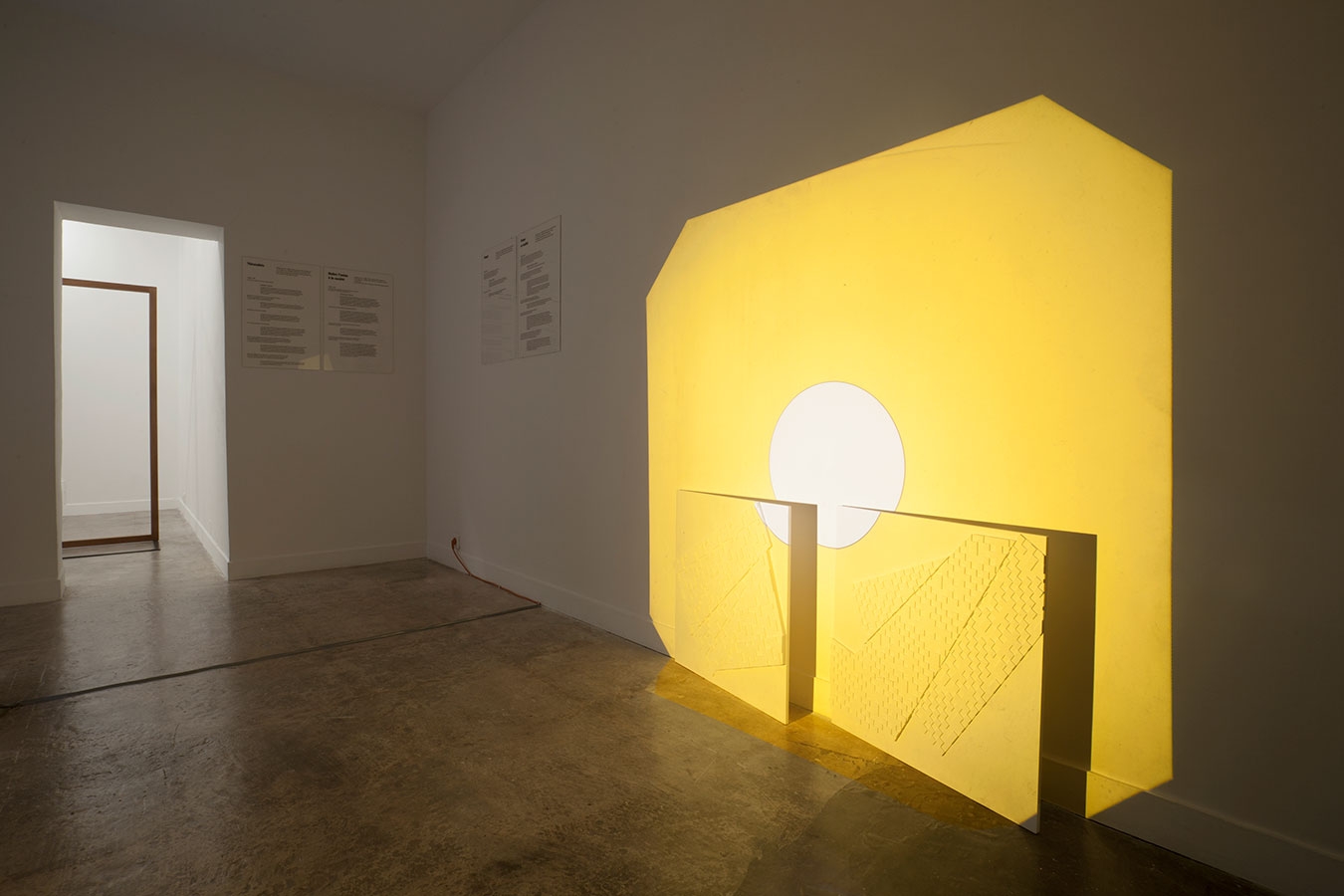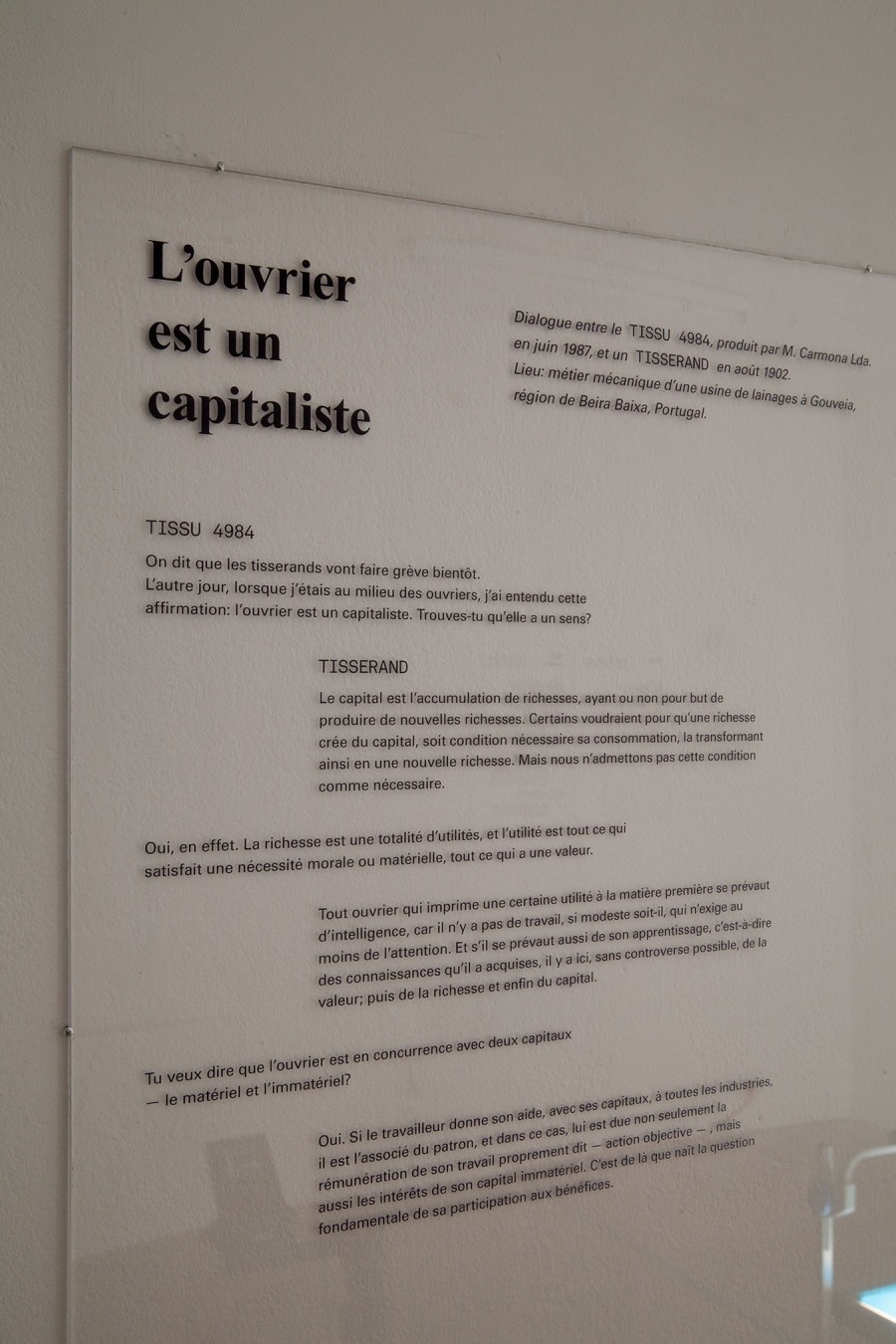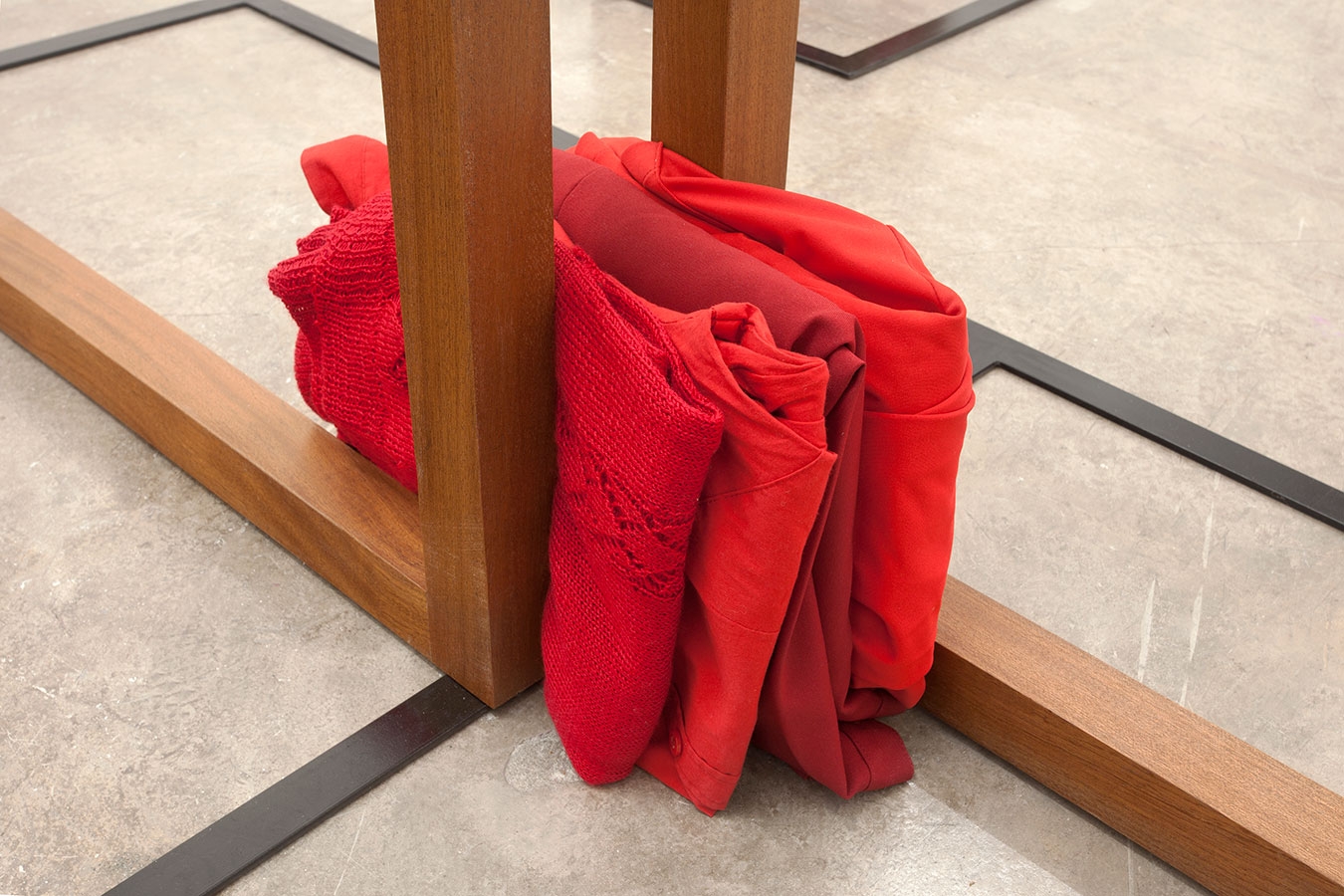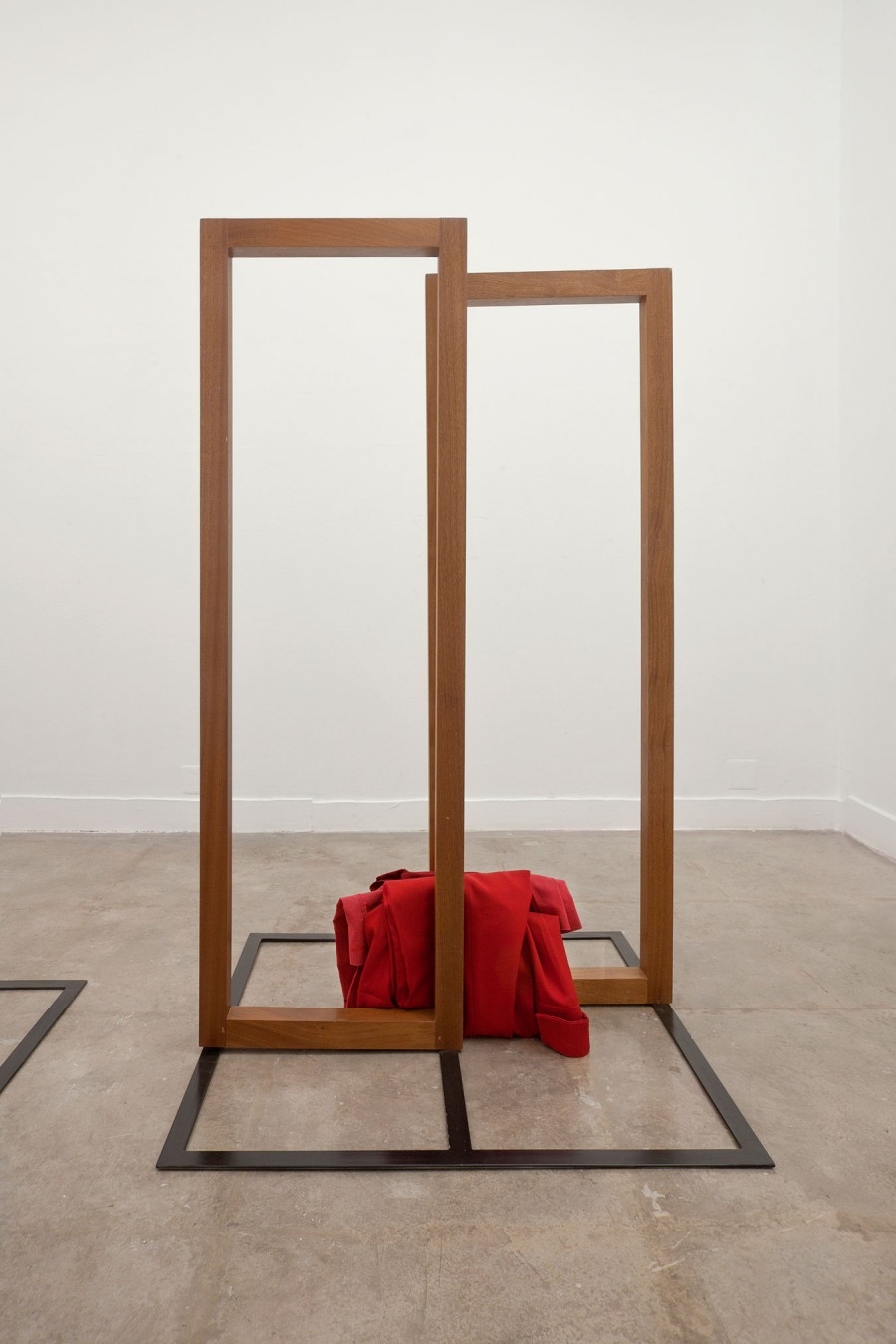Prospectus est un projet d’exposition divisée en plusieurs chapitres. André Guedes y développe, à partir d’un ensemble de tissus manufacturés, une interprétation des problématiques sociales, économiques et technologiques liées à l’industrie textile dans la région de Covilhã au Portugal.
Les tissus qui constituent le corpus de cette étude proviennent de plusieurs usines ayant cessé leur activité dans cette ville industrielle, l’une des pionnières pour la mécanisation pendant la Révolution industrielle au Portugal. La ville de Covilhã fonctionne ici comme un cas paradigmatique dans l’histoire industrielle portugaise, car elle illustre le changement de contexte politique post-colonial et la réorganisation des systèmes productifs et économiques mondiaux de la fin du XXème siècle.
Dans ce deuxième chapitre, The Fabrics Ask / Some Hints on Pattern-Designing, André Guedes emprunte l’idée du livre comme support pour présenter quatre tissus faisant partie de l’ensemble qu’il analyse, proposant ainsi un livre déployé dans l’espace d’exposition où se croisent deux références distinctes : d’une part, l’étude de la morphologie de ces tissus, sa structure visuelle et physique, d’autre part, deux moments-clés de la lutte politique des ouvriers textiles de la région, la grève de 1902 à Gouveia, et les grèves à répétition à Covilhã à la suite de la révolution de 1974.
Différentes sources documentaires ont été transposées afin de mettre en dialogue des agents appartenant à différentes temporalités. Les quatre tissus, produits entre 1987 et 2003, posent ainsi directement des questions aux ouvriers de l’industrie textiles de 1902 et de 1975. Si cette conversation soulève des questions pérennes sur la revendication sociale et économique de la classe ouvrière, elle dégage aussi des éléments subjectifs et anachroniques inhérents à ces discours idéologiques.
Afin d’interpréter ces tissus, Guedes a invité l’artiste portugaise Clara Batalha. Comme les dessins des motifs originaux avait était perdu, il s’est mis en place tout un travail de reconstruction à la fois archéologique et généalogique auquel a participé João Lázaro da Conceição, un ancien designer textile de la région. Les dessins-reliefs élaborés par Clara Batalha à partir d’informations techniques précises suivent alors un processus inverse au processus original – allant du tissu à son dessin-matrice, et non pas de la matrice au tissu – en transformant les motifs originaux en un véritable objet, qu’on peut considérer comme un objet-squelette de sa propre mémoire industrielle.
En langage technique et commercial, on désigne ces tissus comme des tissus “fantaisie”. “C’est aussi le nom donné à un genre de composition musicale fondée sur l’improvisation. On a alors trouvé ici un parallèle entre une composition et une autre, celle de la musique et celle des tissus. Où est questionnée la liberté d’action et d’invention. C’est à dire, sa propre condition d’obéir à une composition donnée (qu’elle soit le tissu, l’usine ou le capitalisme) et la capacité de la changer. “(CB)
Ainsi, les dessins-reliefs, en tant qu’objets dépositaires de mémoire, convoqués dans un possible dialogue, deviennent des «prétextes» pour extraire ce qui n’y était pas visible, ce qui jusque là n’y figurait qu’en sourdine. La fonction qu’ils ont dans ce dialogue (qui se veut également une enquête) entre les tissus et les ouvriers est d’activer et d’extraire le souvenir de leurs préoccupations et de leurs révoltes tout au long du XXème siècle. Les dessins-reliefs sont ainsi des représentants soit d’un processus de production, soit de leur propre parcours historique – spécifique à un lieu et à un temps donnés.
Les dialogues prennent pour origine deux œuvres principales: les articles de l’hebdomadaire ouvrier catholique “O Rebate - Órgão do Operariado Covilhanense” de 1902, et les actes de la 1ère Rencontre Nationale des Dirigeants Syndicaux du Secteur Textile qui a eu lieu à Ofir, région du Minho Littoral, en 1975.
Au coeur du projet Prospectus, figure William Morris, qui donne également à cette exposition le titre de son essai Some Hints on Pattern-Designing (1881).
A ce chapitre de Prospectus ont participé : Ana Baliza, graphiste, Isabel Carvalho, artiste, Helena Correia, conservatrice au Museu de Lanifícios da Universidade da Beira Interior (musée des lainages) à Covilhã, João Lázaro da Conceição, ancien designer textile et conservateur au Museu de Lanifícios da UBI, Jean Pierre Léger, traducteur, et Luís Silva, co-directeur de Kunsthalle Lissabon à Lisbonne. L’artiste tient à remercier l’ensemble de leurs contributions dans ce processus de recherche.
Clara Batalha (1929)
Née à Porto (Portugal), elle obtient en 1952 son diplôme en Art et Géométrie de l’Université de Paris-Sorbonne et suit le cursus des Arts Décoratifs. De 1953 à 1965, elle est à la fois femme de ménage et préceptrice à Paris. Entre 1969 et 1983, elle s’installe dans la région du Douro (Portugal), où elle travaille comme bibliothécaire à la Fondation Calouste Gulbenkian. En 1977 et en parallèle, elle publie le bulletin d’information de la Fondation. Elle collabore actuellement, en tant qu’artiste et chroniqueuse pour les journaux du Haut-Douro et du Minho (régions au nord du Portugal). Depuis 2011, elle présente son œuvre dans Navio Vazio, espace artistique dirigé par l’artiste Isabel Carvalho à Porto. Clara Batalha a collaboré avec André Guedes dans Nova Árgea, présenté en 2012 à la Biennale de Rennes, en créant pour l’œuvre le « Jeu élémentaire de reconfiguration spatiale d’après l’expérience organique d’une communauté définie ».
André Guedes (1971)
Né à Lisbonne (Portugal), il est diplômé d’architecture et s’est ensuite spécialisé en anthropologie de l’espace. Depuis 2002, il réalisé de nombreuses expositions personnelles, parmi lesquelles Nova Argea au Centre Culturel Colombier à la dernière Biennale de Rennes, Pleasure Gardens, Kunsthalle Lissabon, Lisbonne (2012), L’argent, Galerie Crèvecoeur (2010), Airotiv au Centro Cultural Montehermoso à Vitoria (Espagne), The Losts à Bluecoat, Liverpool (2009), Another Trees, Another Switch, Another Smoker and a Prepared Room au Musée Serralves de Porto (2004). Il prépare une exposition personnelle à la Fundacion Calouste Gulbenkian à Lisbonne en 2014. Son travail a également été présenté dans plusieurs expositions collectives dont Itinerarios, Fundacion Botin, Santander (2013), Ca & là / This & there à la Fondation d’entreprise Ricard, Paris (2012), ‘I’m not here. An exhibition without Francis Alys’, De Appel, Amsterdam (2010), World Question Centre, Biennale d’Athènes (2009), Disarming Matter, Dunkers Kulturhus, Helsinborg, Suède, The Clearing, Triennale de Prague (2008).







